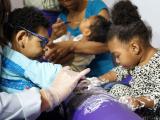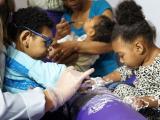Two major US cities—New York and New Orleans—released their Zika virus plans yesterday, as members of Congress pressed their colleagues to take up President Barack Obama's $1.9 billion emergency funding request to help battle the threat.
In new scientific developments, researchers reported more evidence of Zika virus in the cerebrospinal fluid of Brazilian babies born with microcephaly last fall. Also, scientists reported on a new mouse model for studying the disease.
Meanwhile, in outbreak developments, Chile's health minister said Aedes aegypti mosquitoes have been detected for the first time in the country's mainland, the first time in 60 years, Agence France-Presse (AFP) reported today.
The development is significant, because in late January, the Pan American Health Organization said that Chile and Canada were the only countries in the Americas not at risk for Zika virus, because Aedes mosquitoes, the main vector of the disease, aren't found in those two locations.
$21 million investment in New York
With New York City's mosquito season now under way, Mayor Bill de Blasio yesterday shared the details of a $21 million 3-year plan, which builds on existing West Nile virus mosquito control efforts.
In a press release, he said city officials are ramping up plans to respond to any scenario, no matter how unlikely. "We will spare no effort to protect pregnant New Yorkers from the devastating consequences of Zika, and we ask New Yorkers to help us by taking simple steps to get rid of standing water where mosquitoes can breed."
In late March, the US Centers for Disease Control and Prevention updated its mosquito maps for the first time in more than a decade, and they showed expanded ranges for A aegypti and A albopictus beyond the southern tier of states and into the Midwest and East Coast.
Elements of New York's plan include expansion of mosquito surveillance and control, added capacity to test pregnant women and local mosquitoes for the virus, and a public information campaign on prevention and testing. It would add 51 new positions to tackle all the efforts and would double the number of mosquito traps in the city.
The city activated its incident command center in February after the World Health Organization declared a public health emergency due to Zika virus complications, and it put its plan together over the past 2 months following expert consultations. Officials conducted a tabletop exercise of the plan last week.
New Orleans considered high risk
Meanwhile, New Orleans city officials said its comprehensive plan consists of a tiered response based on the threat level. So far only four travel-related cases have been reported in Louisiana, but the document acknowledges that the city is at high risk because of abundant Aedes mosquito populations.
Mayor Mitch Landrieu said in a press release yesterday, "We take the public health threat posed by the Zika virus very seriously." The plan's phases include no reported cases, travel-related cases, and local transmission.
The city has already started its mosquito surveillance program, which is monitoring the two Aedes species thought to spread the virus. Along with traditional mosquito control efforts, it said spray trucks and airplane spraying will be used if needed.
Federal funding impasse
Democratic members of the US Senate yesterday sent a letter to Senate Majority Leader Mitch McConnell, R-Ky., and Appropriations Committee Chair Thad Cochran, R-Miss., calling for immediate passage of Obama's $1.9 billion emergency funding request for Zika prevention and response efforts.
They charged that congressional Republicans have failed to address the request for more than 2 months and urged the Senate Appropriations Committee to mark up the request as soon as possible so the full Senate and House can act on it.
"It would be shortsighted and dangerous for Congress not to act quickly to give the Administration the resources it needs to fully fight the Zika virus and protect Americans," the group said in the letter.
Some Republican lawmakers had insisted that federal officials tap unused Ebola funds, and the Obama administration recently said it would shift $510 million with the caveat that it still needs the full $1.9 billion. Republicans have said they want more information about specific needs and have warned that action might not take place until the fall.
In yesterday's letter, Senate Democrats said the shift in Ebola funds amounts to a 9% loss in federal preparedness money to states.
In a related development, the Obama administration has increased its emergency request to support more work on Zika virus vaccines and diagnostic tests, Stat News reported yesterday, citing an updated request provided by a congressional aide.
The request would boost vaccine research funding to the National Institutes of Health from $130 million to $277 million, paving the way for phase 2 trials in the next fiscal year, and increase the amount to the Biomedical Advanced Research and Development Authority for vaccines and diagnostic tests from $100 million to $188 million, according to the report.
Research developments
- Cerebrospinal fluid testing of 31 babies born with microcephaly in Brazil's public maternity hospitals last September and October showed Zika-specific immunoglobulin M (IgM) in 30, providing strong evidence that the microcephaly was caused by Zika virus infection, Brazilian researchers said in a letter to The Lancet. Zika IgM was also detected in 28 of 31 serum samples from the babies.
- Babies of pregnant women who have hyperglycemia might be especially vulnerable to congenital defect complications from Zika virus infection, Danish experts said yesterday in another letter to The Lancet. They said hyperglycemia during the first pregnancy trimester has been associated with an elevated risk of congenital malformations, including microcephaly, and they urged researchers to investigate its possible role as a contributor to increases in microcephaly in Zika-affected areas.
- University of Wisconsin researchers today published a report on a new mouse model for studying Zika virus. Their findings appear in the latest online edition of PLoS Neglected Tropical Diseases. In a press release from the university, scientists said the mouse model is immunocompromised, like two others that were recently described, but is unique, because it can be used to study how exposure to other viruses, such as dengue, might affect how the body responds to Zika virus infection.
See also:
Apr 18 NYC Health press release
Apr 18 City of New Orleans press release
Apr 19 AFP story
Apr 19 Democratic Policy and Communications Center letter
Apr 18 Stat News story



















